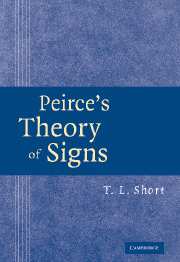Book contents
- Frontmatter
- Contents
- Preface
- Acknowledgments
- 1 Antecedents and Alternatives
- 2 The Development of Peirce's Semeiotic
- 3 Phaneroscopy
- 4 A Preface to Final Causation
- 5 Final Causation
- 6 Significance
- 7 Objects and Interpretants
- 8 A Taxonomy of Signs
- 9 More Taxa
- 10 How Symbols Grow
- 11 Semeiosis and the Mental
- 12 The Structure of Objectivity
- Bibliography
- Name Index
- Subject Index
- Frontmatter
- Contents
- Preface
- Acknowledgments
- 1 Antecedents and Alternatives
- 2 The Development of Peirce's Semeiotic
- 3 Phaneroscopy
- 4 A Preface to Final Causation
- 5 Final Causation
- 6 Significance
- 7 Objects and Interpretants
- 8 A Taxonomy of Signs
- 9 More Taxa
- 10 How Symbols Grow
- 11 Semeiosis and the Mental
- 12 The Structure of Objectivity
- Bibliography
- Name Index
- Subject Index
Summary
Peirce spoke of meaning in a variety of ways, once proposing to make it ‘a technical term of logic’ defined as ‘the intended interpretant of a symbol’ (5.175), another time enumerating the diverse meanings ‘meaning’ has in ordinary usage, including that of purpose (what one ‘means’ to do), suggesting their interconnection (EP2:256). The pragmatic maxim for clarifying meaning (W3:266, cf. chapter 2, section 10) is limited to ‘intellectual signs’. In general, it seems best to declare that Peirce gave the term ‘meaning’ no special place in his semeiotic and that his theory of the interpretant, in its various divisions, is his technical counterpart to the tangled uses ‘meaning’ has in ordinary language. (At least once, he identified a sign's meaning with its immediate object (EP2:274); but the immediate object is a function of the immediate interpretant (chapter 7, section 3).) Similar remarks apply to the term ‘reference’: often used and sometimes explicated, it is not a technical term of semeiotic. Roughly, a sign refers to its dynamic object, and its meaning – as distinct from what it means to someone or what someone means by it – is its immediate interpretant.
Contemporary philosophy of language has been preoccupied with meaning and reference; that is no less true when the idea of meaning is held suspect and attempts are made to get by with reference alone. Peirce's semeiotic should be tested against the arguments of Quine and others.
- Type
- Chapter
- Information
- Peirce's Theory of Signs , pp. 263 - 288Publisher: Cambridge University PressPrint publication year: 2007



